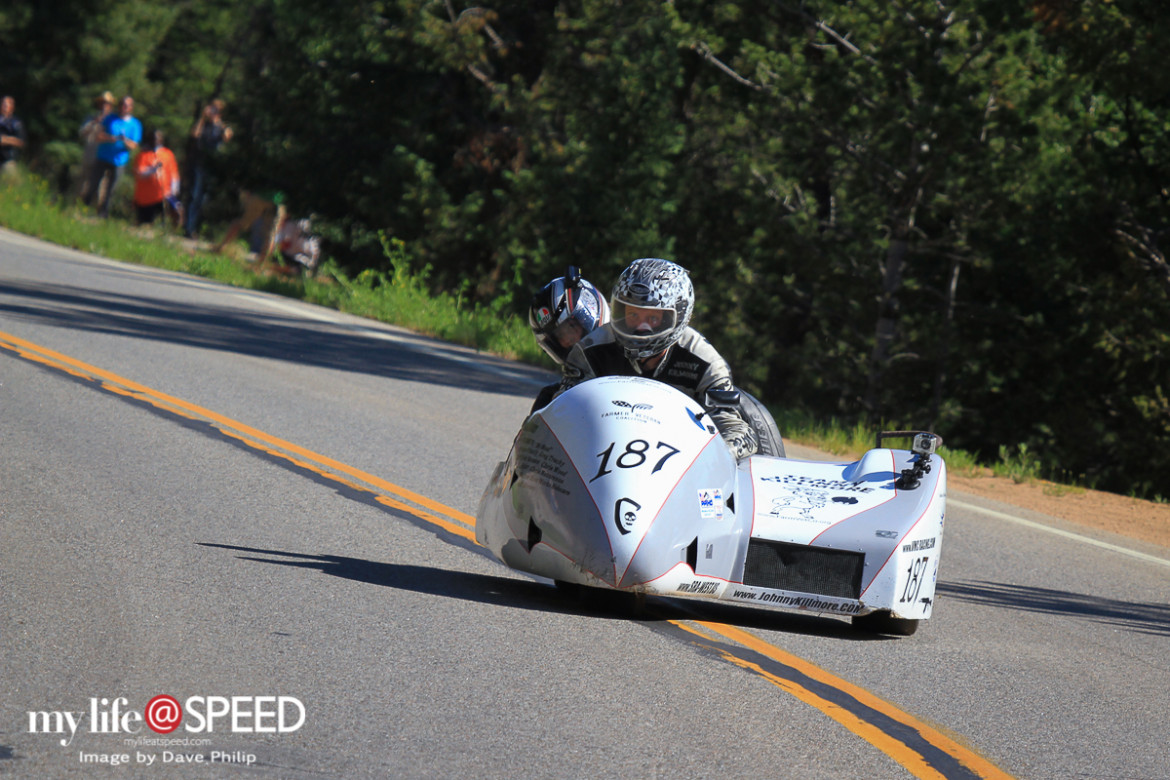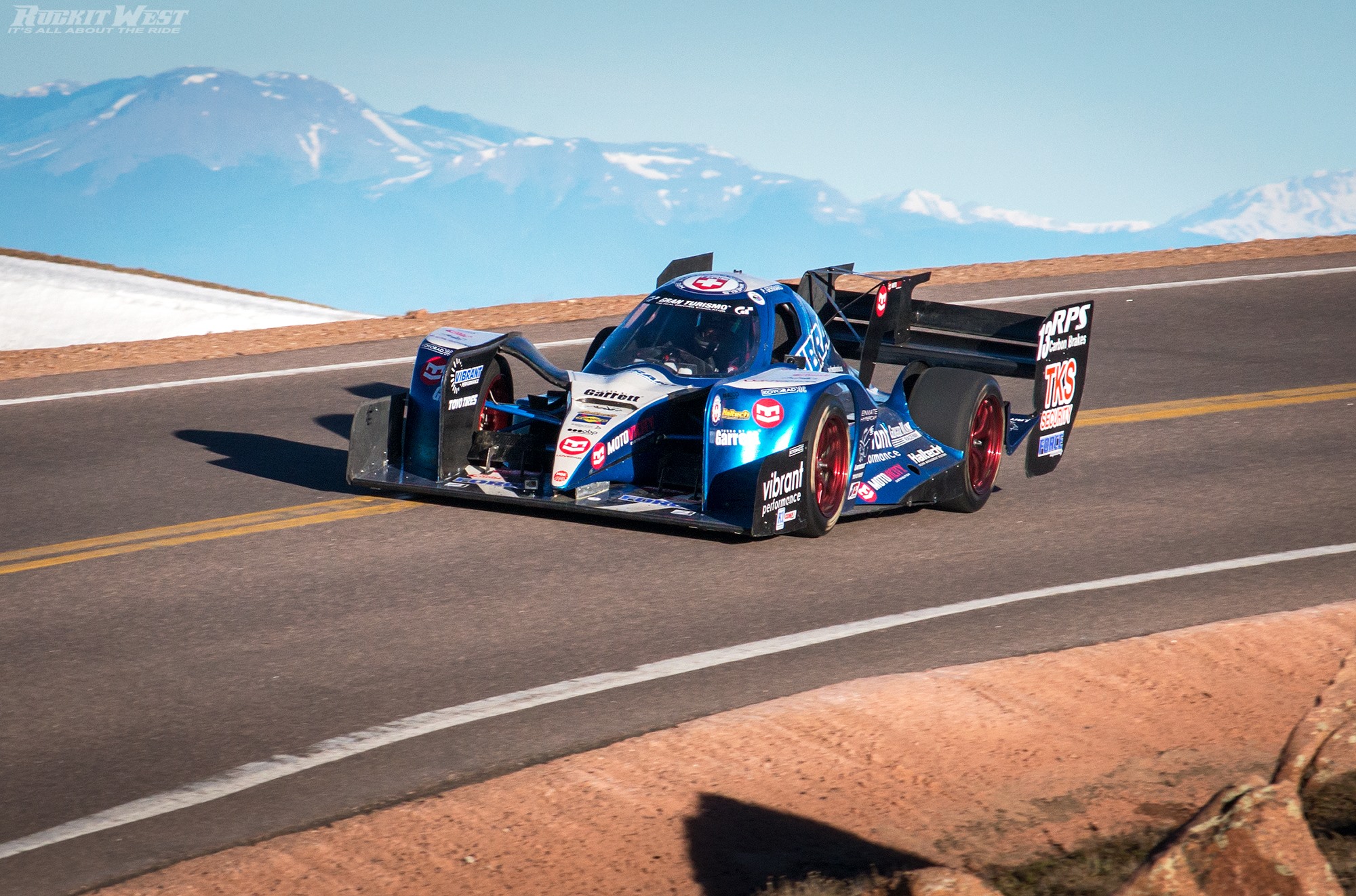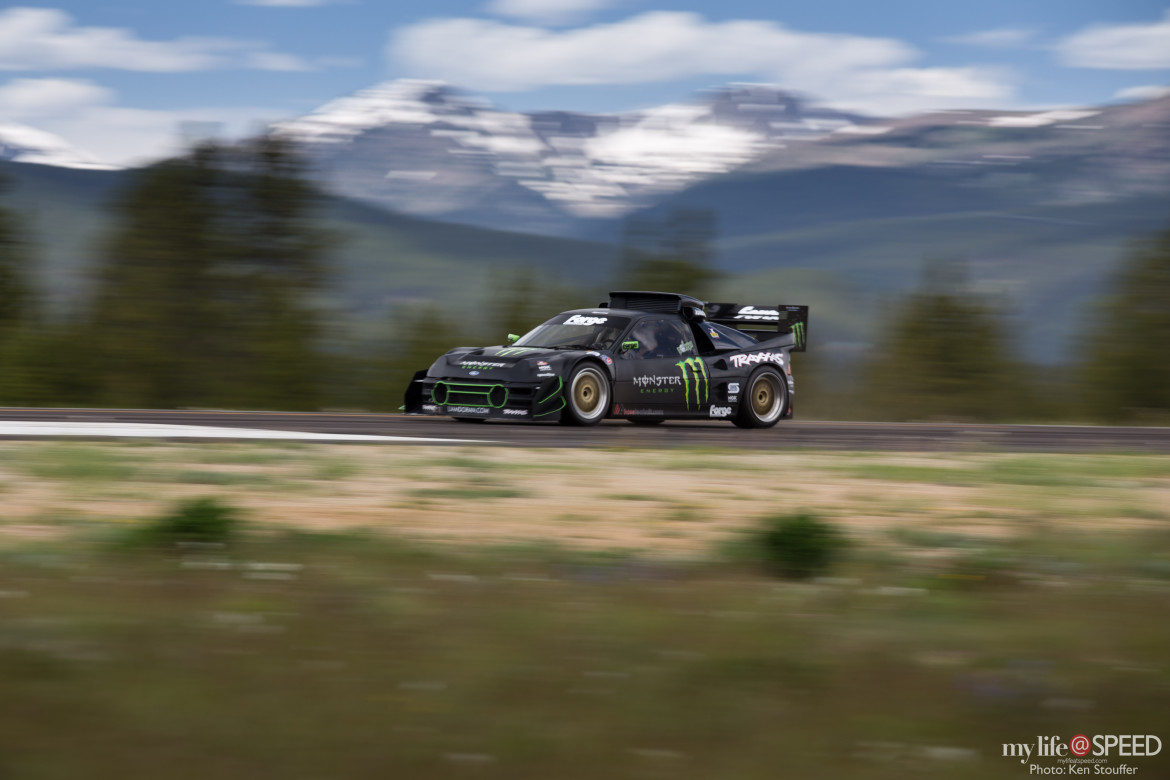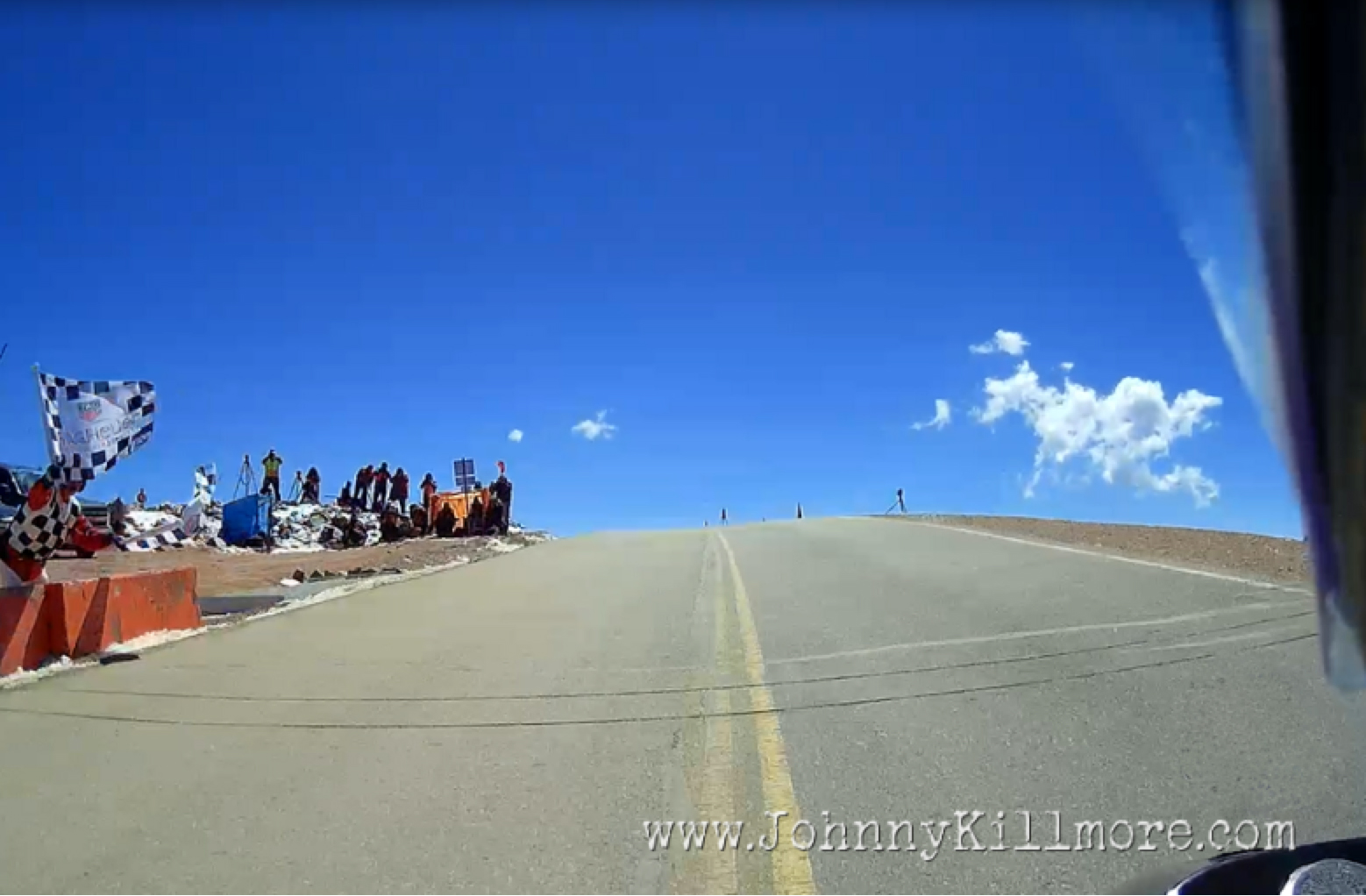PRE-DAWN
The action on race day starts on the way to the pit area. Fans are lining up in one lane of the road and it spills all the way down to the nearby highway in Cascade. You have to work your way through just to queue in line, then work your way up to the entrance. Fans have been parked there for hours since the middle of the night, so they are basically tailgating in the street. Some are sleeping but others are partying, and want to see the sidecar and ask questions. Others attempt to demonstrate their supreme knowledge of motorsport by declaring our bike to be a snowmobile. Once finally inside the park you can wobble through the woods and into a parking space among the trees, and get some more sleep until the sun rises.
After the riders meeting, there is the long wait to be called to pre-grid. This is the only event we attend that has a feeling of anticipation. It is similar to waiting in a military convoy to hit the road for a predawn convoy. It’s much easier to just be on the road doing the job at hand, but I reckon Tom Petty was right when he sang, “The waiting is the hardest part.” There is nothing to do but keep drinking water and try to get easy-to-digest food into your stomach ahead of time. Once on the pre-grid, I checked tire pressure a final time. The rear tire has a noticeable leak so this was of concern. However, since the sun had come up from last I checked them, the rear was at the correct setting and the other two were a few psi above. We readjusted and I mentioned it to Wade Boyd ahead of me… his tires had jumped three psi too high (We run between 15-18psi so three is significant).

During the wait Greg Trachy came by to wish us a good run. That is a really memorable moment because here’s this guy, getting ready to battle for the record as fastest electric vehicle up the mountain, with all the pressures of a factory gig on him; and he takes the time to come over and wish us well. Greg is a true motorhead and is obviously in love with all things that go fast. I’ve been trying awhile now, to find a time to get him on a sidecar, since I think he and his brother Gary would just fall in love with it. From my own experience in laying rubber down, I can say that I’ve found no challenge greater than a road-racing sidecar. Having two people try to figure out a machine that doesn’t behave the same way, in left or right turns is a monumental task. For all intents and purposes, they should not be raced. If they were ideal performance machines, they would still be mass produced. Only the brave and the foolish try to take something this off-balance and hustle it down a race track. I suppose you just love it or hate it. Greg seems the type that is up for a challenge, and I think he would get an absolute blast out of it.

This year had sidecars starting near the end of the running order. Motorcycles would take off with 30-second intervals from the smallest to the largest, with at least a one minute gap between classes. Quads would follow, and then sidecars. With about 170 total entrants you can imagine how long the wait is. All the while we just kept pushing our machine forward and tried to listen to the live commentary, which wasn’t always easy to hear. The red flag came out and it was a long wait for information. One thing to remember about this course is there are no access roads like at a race track. The race track is the access road. When an ambulance needs to head down to the hospital, the entire staging area, full of fans and photographers, needs to clear to let the ambulance through. It’s a grim reminder as the ambulance drives past you, as to what awaits you when the green flag drops.
Nevertheless I was happy when it was our turn to go. Finally… showtime. Wade and Christine were first away and it was actually kind of soothing to watch them leave the line. It was all roaring engine and wheelspin; but it instantly grew silent except for the calm idle of our own engine. The bike was finally handling decently. All the hell we had gone through was behind us. Just 11 minutes or so with one of my most trusted friends, on the most challenging course we’ve ever driven. This is exactly where I’m supposed to be and exactly what I’m supposed to be doing.

THE CRASH
The flagman came up to give me a fist bump which actually pulled me out of my zone for a second. I was so focused on the road ahead; it was difficult to pop back out of that zone where you are connected to the machine. No matter, the signal came and the green flag waved. Visor down, find first gear, and off we go. The launch was good with just the right amount of wheelspin, and immediately we are into the first two corners. We were on our mark and everything felt good. You build a lot of speed coming to the first “real” corner. With cold tires you expect a slide so you turn in early.
Here is where it takes pages of writing to explain five seconds of time. I lifted the throttle a bit and turned into the fast right-hander. The bike went into a slide as predicted, but it lasted just that little bit longer than expected. When it recovered, we were only about four inches off the line I needed us on, but when I turned in to correct it, the steering was still very light. The bike caught another slide and we were dreadfully close to the plastic catch fence on the outside of the corner. I gave a final, desperate try to keep us away from the catch fence. Unfortunately the bike steered under itself. This is a condition where the steering is so responsive that it continues to make an input, after you stop requesting it. In simple terms, you tell the handlebars to turn a little but instead they turn a lot, coming out of your hands a bit. The bike then swung around into a huge slide and we were going backwards at 80mph at least, perhaps faster.


The bike went around backwards so I could no longer see and I just dropped my head back in position and tried to use the mirror. It was useless, so I was using my peripheral vision. The rear brake wasn’t doing much good in reverse and we were drifting toward the catch fencing. If I steered the bike away from it though I risked a “chair away” spin. If the bike spins out with the chair-side trailing the driver side, it will almost immediately flip over due to the low weight on the chair. I had to do something though, so I hammered the bars to the right (toward the catch fence) in the hopes it would whip the nose around in a “chair first” slide. No such luck. We had scrubbed off a lot of speed and there was not enough inertia left. We turned in a lazy way toward the catch fence.
I had to stop us from going off the course at a shallow angle, so I suppose this was better than nothing, but now I was totally out of options. I knew that if we left the course shallow, we would collect a lot of the catch fencing and risk rolling the bike over on the sloping shoulder; or plowing into spectators (I still couldn’t see behind me). However, leaving the track at an almost 90 degree angle wasn’t ideal either… there are trees down there after all. I had no idea what else awaited us. We shot through the fencing with barely a sound and took to the air. We caught a big bounce but still there was no control. Suddenly the first row of trees flew passed. How did we miss them? What else is back here besides…WHAM! We came to a sudden stop but I was not even thrown out of the machine. The engine was still running. I looked for neutral and looked in the mirror for Gina. She was back there I think, standing up.
The onboard views – two shots super-imposed into one video:
How the hell was she already on her feet? I climbed out and she seemed to be trying to figure out what to do. In actuality she had hit her ribs hard on the first bounce. She was on her feet in an attempt to get air to her lungs. She could not communicate of course, and my thought at the moment was to get the bike back to the course before she started trying to help push… she would need to conserve her cardio for the run ahead. I started clearing tree branches and debris out of the way and got back in the bike, as concerned fans started appearing. I ran the bike back up to the edge of the shoulder; but of course it got hung up. I looked back to tell Gina not to help but only saw a spectator there. We pulled a couple times but I was still baffled as to where Gina had gone. I looked back to the impact spot and saw her with her helmet off. My heart sank.

Immediately I ran down to see what was wrong, almost plowing into her. She was obviously flustered but did not seem dazed or wobbly. I don’t remember the exchange (watch the video) but it boiled down to her saying she could still go on and me saying I wanted to continue as well. Truth be told, I was thinking about the cooler full of beer just a few hundred meters behind us. We could just walk back to the pits and put this wretched week behind us. We had been stopped for over a minute and were certainly not going to do anything better than last place. The bravado of “conquering the mountain” was never of much interest to me. I have always felt you are asking that mountain’s permission to go up it, so there is nothing to conquer. The only thing awaiting us at the summit was rain, snow, and maybe some lightning. Still, I suppose there is the “I didn’t want to get dressed up for nothing” mentality and we might as well carry on if we are able to. Back to the bike I went, to finish dragging it onto the shoulder.
The crowd was cheering their encouragement for whatever reason, but I was calmly inspecting the bike. There was a fair-sized dent in the back of the chair but the integrity was not compromised. The brake line to the chair wheel was hanging down but the brake pedal was firm. “Well,” I thought to myself, “might as well just pop up to the top and get a few photos on race day.” Gina hopped onto the bike and I made sure she was okay. I warned her we wouldn’t take any risks. P eople probably wouldn’t believe it, but a co-pilot has a harder time racing at 80% than they do at 100%. The lower side loads while turning, which means less inertia to sling you from side-to-side, and the timing is actually harder to nail at lower speeds.
So off we went up the hill. The rest of the run was nothing to write home about. I actually kept out-braking myself. Approaching a turn at lower speeds than normal, makes you think you can brake later and with less force. Worse yet, the dreaded headshake had returned. The bike was totally nervous and lacked precision. On top of that, the drive chain was full of slack for some reason. Every slow corner we pulled out of, the chain would hop on the rear sprocket horribly. We caught Hans and Steve a little before halfway. Of course with six sidecars on 10 second intervals we were technically a minute behind them, so I dispatched them quickly on the brakes and began to carry on.

We were an absolute mess with the chain skipping, the head shaking, the brakes locking, and a horrible sense of timing. You simply can’t go “kinda fast” with a race machine… you either go all out or you drive it. You cannot operate at those speeds while only “mostly” paying attention. Fortunately we never hit anything and we got to the summit without further drama. Dejected as I was, Gina must have sensed it as she seemed strangely concerned with consoling me. She could obviously tell I was bummed out, but really there was little to say. I just wanted to get the bike on the trailer, but we were going to be at the summit for hours more.
AFTER THE DUST SETTLES
The summit wasn’t much to look at this year honestly. Usually the view is astounding, but things were pretty gray up there. There was some talk of getting us down to the start line before the cars started their runs; but with several delays during the race, I knew that wasn’t going to be the case. Strangely there was some false word about heading down and everyone suited up; but was told to shut the motors down. No matter, I expected a long stay. We found the official results and I don’t even remember our time. Wade and Christine had gotten the win and knocked about 20 seconds off our record from last year. I expected that though last year I also had a spin and had to detour through the dirt to keep going, barely winning by 3-4 seconds; I was expecting to knock 20-30 seconds off our time this year. At least, I thought that before everything started going wrong. Gina took note that we were only 3-5 seconds short in the section times (not including where we crashed). There’s really nothing to draw from that however, as we weren’t going at race pace; plus the headshake and chain-skip were both so bad. There’s no telling what any of that was worth in numbers of seconds.

Truthfully it was all irrelevant to me. The main goal for me was to put in a run I could be proud of. If the end result is winning, that is a great bonus. See, if you win but the run felt like total crap, it really doesn’t matter all that much that you won (for me at least). You leave knowing you could have done better. If you leave in second or fourth place or whatever, but know you couldn’t have done any better, you leave hungry and full of ideas on how to push past your boundaries. That’s the whole game to me: find a boundary and prove it is not real. Then find the next one and repeat. Sidecar racing is never going to make me rich or famous. You do not do this because you want to prove yourself to other people. This isn’t about adoration or riches or having a TV movie made about you. No, this is about finding the sliver of space where the world drops all of its pretense and you simply live as an expression of excellence. Not for your own reward, but simply for the pursuit of excellence itself. When I pull off something in life that is truly amazing I think, “Look at that,” not “Look at me.” Unfortunately, this year there was not a lot to look at.
After spending hours watching the cars come up and the terrible coverage from the announcers, I was certainly ready to head down the hill. Greg Trachy also ran into bad luck as well. Despite being dead fast in his Mitsubishi electric car all week, he finished third. The road was wet from rain and continued to dry so that each car in his class was getting a progressively drier track. With Greg qualifying fastest, he had to leave first (some reward, eh?) Things like that are a bummer to deal with. On the one hand it’s just a natural occurrence, literally a condition of nature. On the other hand the race organizers knew the conditions and chose not to wait for the track to dry. You can’t really fault the organizers either though, as they have to get the entire event in and give everyone some racetrack to run on, before the sun sets. It was just a shame all around. Bad luck. A nd there was bad luck for several cars. Two or three spun in the same corner we did; but went off the inside of the track where large boulders are. The two I saw were complete write-offs.
For us sidecar folk it was at least kind of nice. The Japanese team (Masahito Watanabe/ Takeshi Yasuda) were able to come in second place, which must have been a huge joy for all their effort (and only having a 600cc engine). One of the French teams (“Les Marluches”) came in third on their road-based Benelli sidecar, meaning they could take a trophy home to Europe. It was also a great win for Wade Boyd and Christine Blunk, who managed at least to keep the record on American soil. This is their second year on the hill and their times are very competitive. Of course, I expect to return and get the record back in our hands in 2015. Still, the important fact is that the sidecar class had a really good result as an entity.
The awards ceremony ran past sunset, but that allowed traffic to abate somewhat and we were down the hill pretty quickly. I remember being invited back to the hotel where Greg Trachy and the My Life At Speed crew were hanging out, but Gina and I were totally wiped out. I remember it already being 9pm and thinking it felt like 2am, so other than food and beer, I only remember falling asleep without having to set the alarm clock, and feeling fantastic about it. In the morning we packed up and were on the road pretty early, after taking some pictures and saying goodbye to the Wagner family once again. They are really cool people and such wonderful hosts.
The trip home was a continuation of mechanical misery, as I lost track of how many times we had to pull over (15-20 times) to let the engine cool. I was totally deflated by the time we got back, compounded by the fact that I had to take Gina to the airport almost immediately. As much as we get to see each other, it is never enough because we are always focused on racing. It’s a condition that will hopefully change in the off season, as being around someone only when it’s high-stress, fast-paced, and money-bleeding isn’t a very cool situation. But with Gina on the plane and I back home (after one final time overheating while trying to climb back into the desert), I could finally shut the gate on this nightmare called Pikes Peak 2013.
Next year looks to be off the table for us due to our expected entry in the Isle of Man TT races. This is the biggest sidecar event on the planet without exception; and it will be worth missing Pikes Peak to attend. But it also means the frost heaves will continue to add big waves to the asphalt up top and make a solid record-attempt harder each year. Add to that the unknowns of weather on race day and constantly changing rules (road legal tires only, then slicks allowed, then back to road tires) and it remains a total unknown as to how clear a shot we will ever get in the Race to the Clouds.
Team Johnny Killmore would like to thank The Farmer Veteran Coalition, Victorville Motorcycle Center, and My Life At Speed for their support this year, along with the following contributors:

See our candid photo gallery here
;




